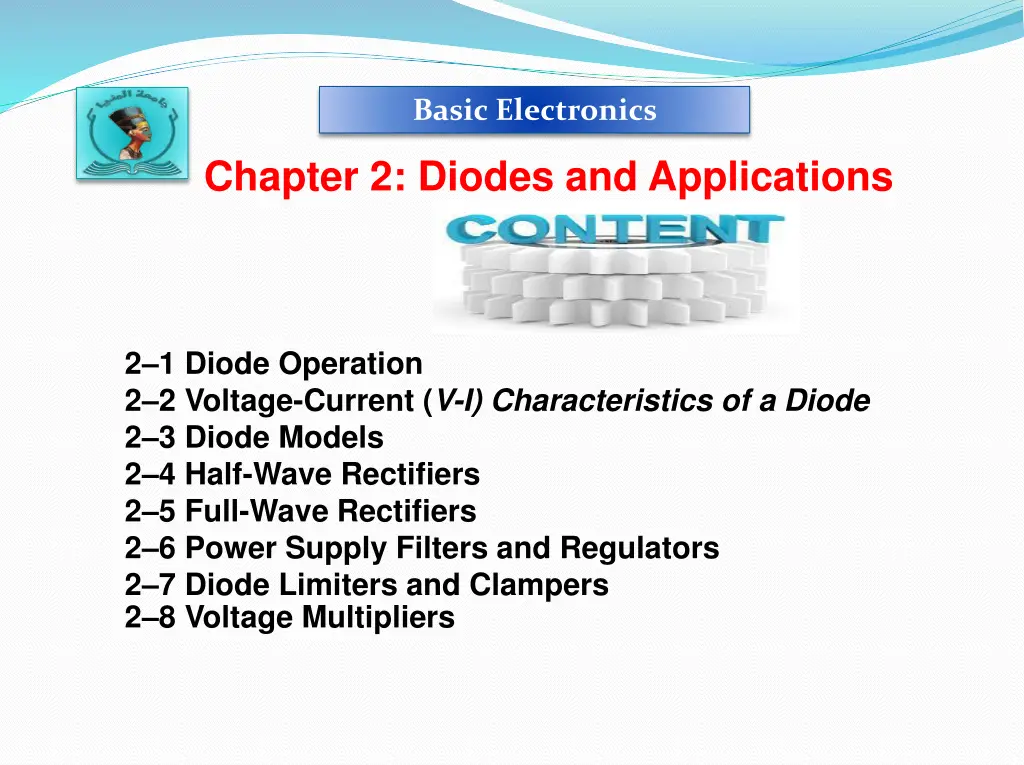
Understanding Diodes: Operations, Characteristics, and Applications
Explore the operation and characteristics of diodes in electronics, including forward and reverse bias, V-I characteristics, diode models, rectifiers, power supply filters, regulators, limiters, clampers, and voltage multipliers. Learn how diodes are used in common applications and analyze key aspects of diode behavior for efficient circuit design.
Download Presentation

Please find below an Image/Link to download the presentation.
The content on the website is provided AS IS for your information and personal use only. It may not be sold, licensed, or shared on other websites without obtaining consent from the author. If you encounter any issues during the download, it is possible that the publisher has removed the file from their server.
You are allowed to download the files provided on this website for personal or commercial use, subject to the condition that they are used lawfully. All files are the property of their respective owners.
The content on the website is provided AS IS for your information and personal use only. It may not be sold, licensed, or shared on other websites without obtaining consent from the author.
E N D
Presentation Transcript
Basic Electronics Chapter 2: Diodes and Applications 2 1 Diode Operation 2 2 Voltage-Current (V-I) Characteristics of a Diode 2 3 Diode Models 2 4 Half-Wave Rectifiers 2 5 Full-Wave Rectifiers 2 6 Power Supply Filters and Regulators 2 7 Diode Limiters and Clampers 2 8 Voltage Multipliers
Use a diode in common applications Analyze the voltage-current (V-I) characteristic of a diode Explain how the three diode models differ Explain and analyze the operation of half-wave rectifiers Explain and analyze the operation of full-wave rectifiers Explain and analyze power supply filters and regulators Explain and analyze the operation of diode limiters and clampers Explain and analyze the operation of diode voltage multipliers
Diode Bias Forward bias Reverse bias V-I characteristic DC power supply Rectifier Filter Regulator Half-wave rectifier Peak inverse voltage (PIV) Full-wave rectifier Ripple voltage Line regulation Load regulation Limiter Clamper
21 DIODE OPERATION diode is made from a small piece of semiconductor material, usually silicon, in which half is doped as a p region and half is doped as an n region with a pn junction and depletion region in between. The p region is called the anode and is connected to a conductive terminal. The n region is called the cathode and is connected to a second conductive terminal
Typical diodes packages surface mounting on a printed circuit board Through-hole mounted diodes
Forward Bias Is the condition that allows current through the pn junction. Notice that the negative side of VBIAS is connected to the n region of the diode and the positive side is connected to the p region. This is one requirement for forward bias. A second requirement is that the bias voltage, VBIAS, must be greater than the barrier potential. A diode connected for forward bias.
This flow of free electrons is called electron current A forward-biased diode showing the flow of majority carriers and the voltage due to the barrier potential across the depletion region.
Reverse Bias Reverse bias is the condition that essentially prevents current through the diode. A diode connected for reverse bias. A limiting resistor is shown although it is not important in reverse bias because there is essentially no current.
The diode during the short transition time immediately after reverse-bias voltage is applied.
The conduction band in the p region is at a higher energy level than the conduction band in the n region. The extremely small reverse current in a reverse-biased diode is due to the minority carriers from thermally generated electron-hole pairs.
22 VOLTAGE-CURRENT CHARACTERISTIC OF A DIODE V-I Characteristic for Forward Bias
V-I Characteristic for Reverse Bias V-I characteristic curve for a reversebiased diode.
The Complete V-I Characteristic Curve The complete V-I characteristic curve for a diode.
Temperature effect on the diode V-I characteristic. The 1 mA and marks on the vertical axis are given as a basis for a relative comparison of the current scales.
23 DIODE MODELS The Ideal Diode Model The Complete Diode Model The Practical Diode Model
Forward voltage and current Reverse voltage and current VF = 0 V
Forward voltage and current Reverse voltage and current VF = 0.7 V
